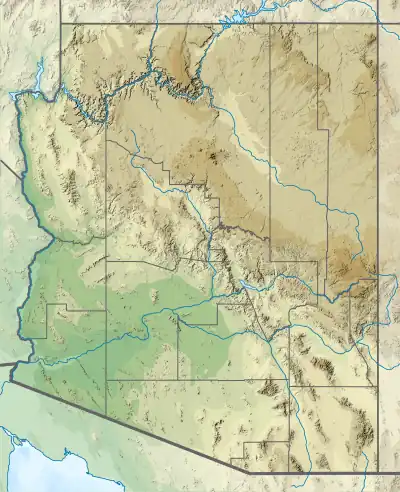Nugent's Pass
Nugents Pass or Nugent's Pass is a gap at an elevation of 4,593 feet (1,400 m) in Cochise County, Arizona. The pass was named for John Nugent, who provided notes of his journey with a party of Forty-Niners across what became the Tucson Cutoff to Lt. John G. Parke, on expedition to identify a feasible railroad route from the Pima Villages to the Rio Grande.[2]
| Nugents Pass | |
|---|---|
 The pass is located in Cochise County | |
| Elevation | 4,593 ft (1,400 m)[1] |
| Location | |
| Coordinates | 32°11′00″N 110°06′02″W |
| Topo map | USGS Steele Hills |
History
Nugent's Pass was an early alternate route of the Southern Emigrant Trail, called variously the Tucson Cutoff or "Puerto del Dado" Trail (later Apache Pass Trail). Long traveled by Spanish and Mexican soldiers and other early explorers, its first American travelers were likely fur trappers. The route became known to westward-bound American emigrants after it was traveled by a party of Forty-Niners led by John Coffee Hays in 1849.
The Tucson Cutoff ran from Cooke's Wagon Road on the east side of the Animas Valley west through Stein's Pass to the cienega on the nearby San Simon River; through Puerto del Dado to Dos Cabezas Spring; across the Sulphur Springs Valley and Willcox Playa to Croton Springs; through Nugent's Pass; down Tres Alamos Wash to the lower crossing of the San Pedro River near Tres Alamos; and finally southwest from Tres Alamos to a waterhole on Cooke's Wagon Road on Mescal Wash (just west of modern Mescal), where it linked up again with Cooke's route to Tucson.[3][4][5]
In the later 1850s, the stagecoach routes of the San Antonio-San Diego Mail Line and Butterfield Overland Mail diverted from the Nugent's Pass route at Dos Cabezas Spring to a shorter route south of Willcox Playa, through Dragoon Pass to the middle crossing of the San Pedro River (below the rail and highway bridges of modern Benson and south of Pomerene). However, Nugent's Pass remained in use as a wagon route between the San Pedro River and the Sulphur Springs Valley for many decades afterward.[6][7][8][9]
References
- "Nugents Pass". Geographic Names Information System. United States Geological Survey, United States Department of the Interior. Retrieved July 22, 2014.
- Report of Captain A. A. Humphreys, Topographical Engineers, Upon the progress of the Pacific Railroad Expeditions and Surveys, Report of the Secretary of War, Dec. 1, 1856, Message from the President of the United States to the Two Houses of Congress at the Commencement of the third session of the 34th Congress, 34th Congress, 3d Session, House of Representatives, Ex. Doc. No. 1, Vol. II, Cornelius Wendell, Washington, 1856, pp. 206–209
- John P. Wilson, Peoples of the Middle Gila: a Documentary History of the Pimas and Maricopas, 1500s–1945, Researched and Written for the Gila River Indian Community, Sacaton, Arizona, 1999, p. 111
- Robert Eccleston, Overland to California on the Southwestern Trail 1849, University of California Press, Berkeley, 1950, pp. 174–193
- Richard J. Hinton, The Handbook to Arizona: Its Resources, History, Towns, Mines, Ruins, and Scenery, Payot, Upham & Company, 1878 Archived 2014-06-28 at the Wayback Machine pp. xix–xx, xxxi
- Table of distances from Texas Almanac, 1859 Archived 2013-11-12 at the Wayback Machine, Book, ca. 1859; digital images, (http://texashistory.unt.edu/ark:/67531/metapth123765/ Archived 2013-11-12 at the Wayback Machine accessed November 12, 2013), University of North Texas Libraries, The Portal to Texas History, http://texashistory.unt.edu Archived 2000-02-10 at the Wayback Machine; crediting Texas State Historical Association, Denton, Texas
- List of Stations from New York Times, October 14 1858, Itinerary of the Route
- "Trapp, Edward, Military Map of Arizona, Engineer Office, Military Division of the Pacific, 1869, from the Sharlot Hall Museum Map Collection, Arizona Memory Project at azmemory.azlibrary.gov accessed Feb. 18, 2014". Archived from the original on 2014-02-28. Retrieved 2014-02-20.
- Hinton, Richard Josiah (1878). Richard J. Hinton, The Handbook to Arizona: Its Resources, History, Towns, Mines, Ruins, and Scenery, Payot, Upham & Company, San Francisco, 1878, pp. xix–xx, xxxi. ISBN 9780598277268. Archived from the original on 2014-06-28. Retrieved 2016-10-31.